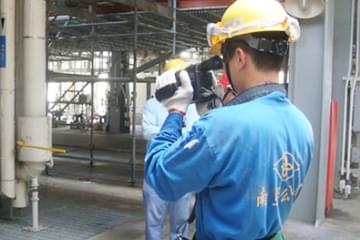
Air pollution control management
Optimization of air pollution control equipment
FPG has actively made improvements in air pollution control over the years, and has accumulated considerable experience. We continue to use the best process technologies and improve air pollution control systems, including selective catalytic reduction (SCR), flue gas desulfurization (FGD), low NOx burner, high temperature oxidizer, activated carbon adsorption system, and closed coal bunker and transportation system, in order to properly carry out environmental protection actions. We keep the equipment working at their best performance through preventive maintenance, training, and operations, and thereby effectively carry out pollution control tasks. At present, our air pollution control results have already exceeded national standards, and are among the best in the world.
FPG no longer uses Halons, CFC-11, and CFC-12, which damage the ozone layer, and also mainly use the coolants R-134A and R-140A, which is aligned with international standards and the government's policy of implementing the "Montreal Protocol".


Implementation of strict VOCs reduction and odor control
Mailiao Park is the first industrial park in Taiwan to implement cap control. Apart from the pollutants that already meet environmental impact assessment requirements, we continue to actively make improvements to reduce VOCs. As of 2022, we invested NT$4.326 billion in a total of 691 improvement projects.
Improvements of FPG in Mailiao Park for VOCs reduction over the years


To prevent fugitive VOCs emissions, prevent leakage of raw materials and products, and reduce complaints from residents about foreign odor, FPG spared no expense in purchasing 39 GasFindIR infrared leakage detection cameras, which are used by the military in the US. This makes it possible to quickly find the source of leaks and immediately make improvements. Statistics of the competent authority of environmental protection on audits of Mailiao Park in recent years show that equipment VOCs leakage has gradually decreased to only 0.033% in 2023.



Water pollution control management
FPG properly plans wastewater treatment facilities based on the characteristics of wastewater sources in each park. Facilities include physical and chemical treatment, such as neutralization, sedimentation and float removal, biological treatment, and film treatment. A dedicated wastewater treatment department is established and personnel are appointed. The personnel receive periodic training to effectively manage wastewater treatment, so that the quality of effluents meets national effluent standards. Depending on the location of the park, ocean discharge (e.g. Mailiao Park discharges wastewater into the Taiwan Strait), river discharge (e.g. Jinxing Park discharges wastewater into Taoyuan Nankan River, Xingang Park discharges wastewater into Chiayi Niuchou River, and Renwu Park discharges wastewater into Kaohsiung Houjing River), or wastewater is discharged into nearby bodies of water after treatment in the industrial park's wastewater treatment plant according to the Water Pollution Control Act.

Formosa Petrochemical Corporation wastewater treatment plant

Nan Ya Plastics Corporation wastewater treatment plant (includes fish ponds)


Waste Management
Waste management is divided into 4 stages: sorting at the source, process waste reduction, and recycling and reuse, which aim to reduce the amount of waste that is incinerated and buried, with the ultimate goal of achieving zero waste and zero landfill.


Reuse is prioritized in waste disposal, followed by incineration and burial. FPG generated a total of 2,615,866 tons of waste in 2022. After sorting, recycling, and reuse, 2,494,188 or 95.35% was reused.


Total
2,560,627
tons
100.00
%
Source: The Formosa Plastics Group waste management computer-based database


